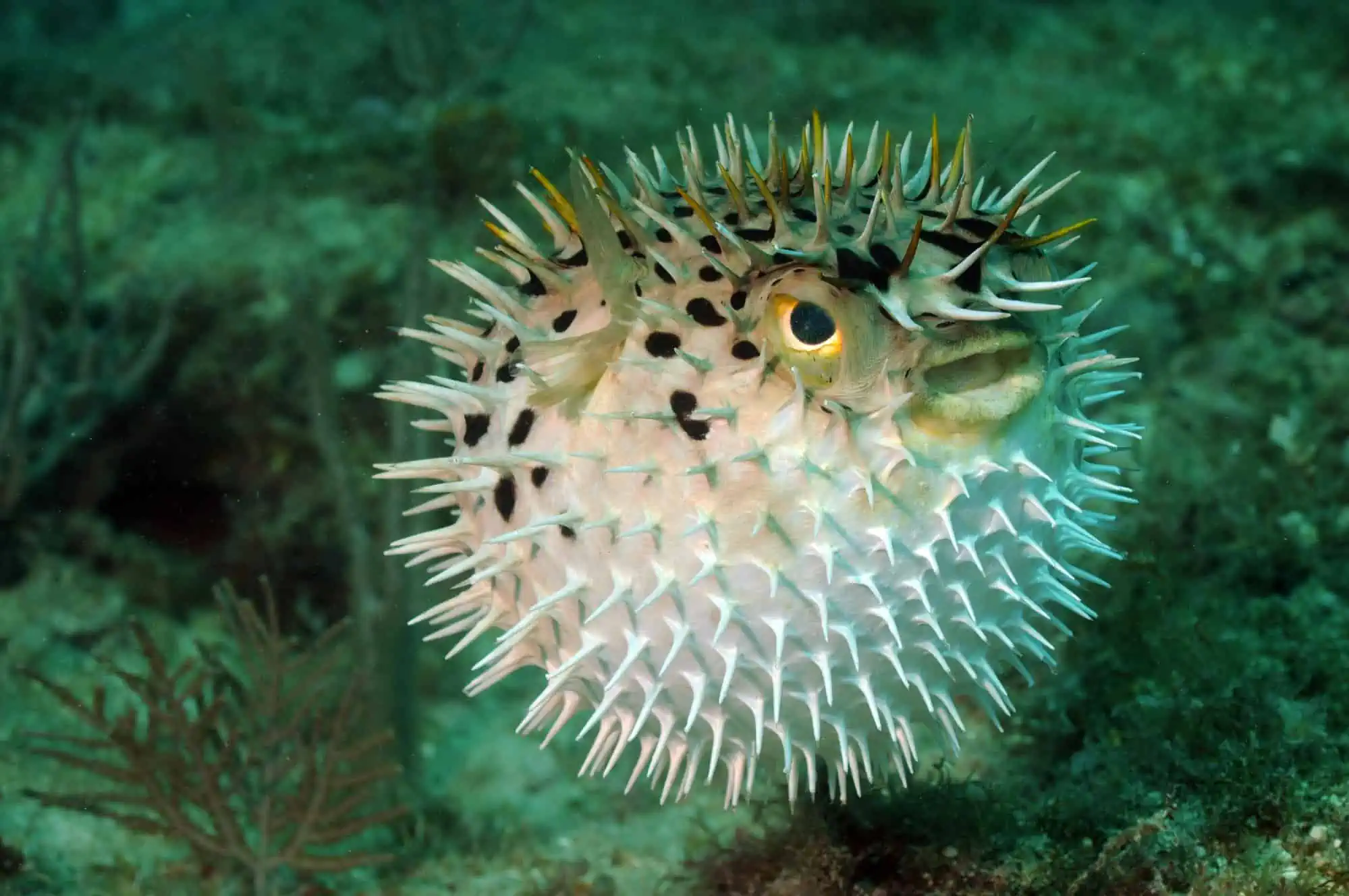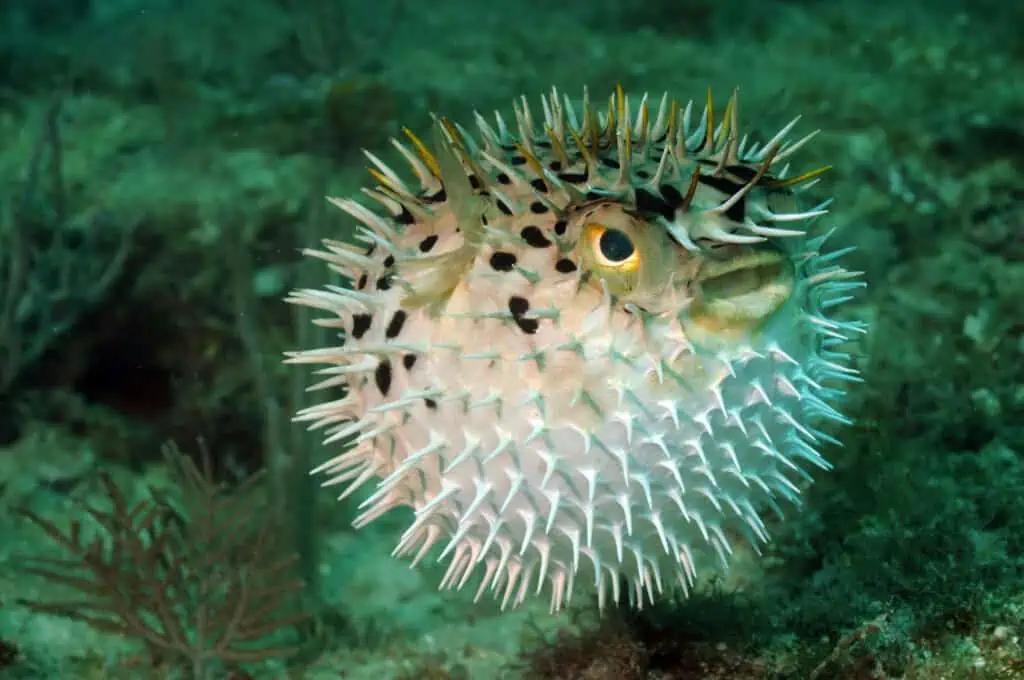Most aquarium fish cannot be described as cute or endearing. However, the porcupine puffer fish, or blowfish as it is sometimes also known, does fit both those labels.
Hobbyists love these weird-looking fish for their big personalities and strange appearance, but does the porcupine puffer have a place in a marine community or reef tank, and are these prickly customers easy to care for?
Read this guide to learn everything you need to know about the delightful porcupine puffer fish and its care requirements.
Porcupine Puffer Fish – At a Glance
| Porcupine Puffer Info | |
|---|---|
| Scientific Name | Diodon holocanthus |
| Common Name (species) | Porcupine puffer fish, blowfish, porcupinefish, balloonfish |
| Family | Diodontidae |
| Origin | South East Asia |
| Diet | Carnivore |
| Care Level | Advanced |
| Activity | Active around all areas of the tank |
| Lifespan | Between 10 and 15 years |
| Temperament | Semi-aggressive |
| Minimum Tank Size | 200 gallons |
| Temperature Range | Tropical 75° to 82° Fahrenheit |
| Salinity | 1.020-1.025 |
| pH Range | 8.1 to 8.4 |
| Filtration/Flow Rate | Prefers a low flow rate |
| Water Type | Saltwater |
| Breeding | Broadcast spawners |
| Compatibility | Not reef-safe but can live with some larger marine fish species |
Origins and Habitat
The porcupine puffer fish has the scientific name Diodon holocanthus. These fish also have several common names, including:
- Porcupinefish
- Balloonfish
- Blowfish
Porcupine puffer fish, scientifically known as Diodon holocanthus, are native to the warm coastal waters of the Pacific and Indian Oceans.
These waters are abundant with coral reefs, lagoons, and seagrass beds, offering the perfect habitat for this unique species. Vibrant coral formations and the myriad hiding spaces they present ensure the porcupine puffer can easily shelter from predators and seek out its prey.
What Do Porcupine Puffer Fish Look Like?
Porcupine puffers are famous for their looks! When relaxed, a porcupine puffer fish is a long oval shape, with flattened spines all over the body. The fish have strong, beaky teeth that give the creature the look of a permanent grin, and their brown color freckled with spots adds to the fish’s comedic look.
When the porcupine puffer is agitated or frightened, it has the ability to swallow large amounts of water, which causes the fish to puff up. That behavior is common to all puffer fish varieties. However, the porcupine puffer has an armor of impressive needle-sharp spikes that stand straight up when the fish inflates itself.
These fish are not small, potentially reaching a size of around 20 inches!
How Long Do Porcupine Puffer Fish Live?
Porcupine puffers are relatively long-lived fish. In the wild, the fish typically live from 10 to 15 years, provided predators do not prematurely catch them or face environmental threats. In captivity, with proper care, the porcupine puffer often lives for about ten years, with their lifespan largely influenced by factors such as diet, tank conditions, and each specimen’s overall health.
Behavior
Porcupine puffer fish are best known for their distinct behavior.
When threatened, the fish has the unique ability to inflate its body by swallowing water or air, turning itself into a balloon-like shape, bristling with lethal spines. The idea of this spectacular transformation is to create an effective deterrent against potential predators. After all, not many fish would risk attempting to swallow a mouthful of needles!
Beyond this defense mechanism, the porcupine puffer is generally curious and playful and can even recognize its owners over time.
Is the Porcupine Puffer Fish Fish Poisonous?
In some countries, puffer fish is considered a delicacy and is served in exclusive restaurants as a dish called Fugu, which can only be prepared and cooked by a specially-trained, licensed chef.
The toxin Fugu contains in small amounts can produce tingling or numbness in the diner’s lips or mouth and even produce a small “high.” However, if the wrong organs of the fish are ingested, the toxin is so strong that it often proves fatal.
What About Porcupine Puffer Fish and Aquarium Safety?
Keeping a porcupine puffer fish in an aquarium requires certain precautions and knowledge to ensure safety both for the fish and the keeper. For that reason, we recommend that only experienced aquarists take on one of these quirky fish.
Porcupine puffers must be handled with care since they possess a venomous toxin in their skin, which can irritate the skin and cause an allergic reaction in some people. Avoid handling the puffer fish directly. If you need to move the fish, use a soft net or container.
In addition, porcupine puffers can inflate as a defense mechanism, and doing so out of water can be very dangerous for them. If the fish ingest air, it can be difficult for them to expel it, which can be lethal.
Temperament and Tank Mates

Choosing compatible tank mates for your porcupine puffer is challenging. Small fish are usually considered a food source, while slow swimmers with flowing tails and fins are usually nipped at.
Large fish species can stress your puffer, although wrasses and tangs generally do well if you want to keep your puffer fish with a few tank mates in a large aquarium.
Keeping Porcupine Puffer Fish Together
Porcupine puffers can be kept with others of their own species, as they do sometimes occur in small groups of youngsters. However, given how much waste the fish produce, keeping them in groups is not easy.
Can You Keep Porcupine Puffer Fish With Shrimp?
It’s generally not advisable to keep porcupine puffers with invertebrates and corals. These are carnivorous fish that love to eat crustaceans, and in a tank environment, shrimp and other smaller invertebrates often end up as a tasty snack for the puffer.
Porcupine Puffer Fish Care Guide
In this part of our guide, we explain how to care for porcupine puffer fish in the aquarium.
Tank Size
Given the porcupine puffer’s potential size of 12 inches or more and its active nature, porcupine puffers need a spacious tank, so a minimum of 200 gallons is recommended.
A long rectangular tank is preferred, as that allows more surface area for efficient gaseous exchange and gives the fish plenty of open water swimming space.
Filtration
In addition to a large aquarium, you will need a very powerful filtration system to cope efficiently with the amounts of waste these voracious carnivores produce.
Water Parameters
Maintaining stable water parameters is crucial for the porcupine puffer fish. The water temperature should range between 75 and 82°F, with a pH level of 8.2 to 8.4. Salinity should be 1.020 to 1.025.
Of course, ammonia and nitrite levels should be zero, and nitrates should ideally be below 20 ppm.
You should carry out partial water changes and monitor the water parameters in the aquarium on a weekly basis to ensure the environment remains stable and correct for the fish.
Decoration
To replicate the porcupine puffer’s natural habitat, you could consider using live rock and sand substrate. That environment provides the fish with ample hiding spaces and also encourages the growth of natural prey like algae and small crustaceans.
Lighting
Regular aquarium lighting is fine for porcupine puffer fish, although they do need a natural day-night cycle, which is beneficial for their overall well-being.
What Do Porcupine Puffer Fish Eat?
One of the reasons keeping porcupine puffer fish is so challenging is their diet. The fish’s teeth do not stop growing, which is handy since they live off mollusks and other hard-shelled invertebrates that would easily wear down their teeth.
However, that causes a problem for the accurist in that you need to feed your porcupine puffer fish a diet that consists almost entirely of hard foods such as clams, in-shell mussels, crabs, and the like. If you don’t do that, your fish will eventually be completely unable to eat because of their overgrown teeth.
Some pufferfish owners prefer to file down or cut their fish’s teeth, although that’s easier said than done and can be highly stressful for the fish. If something goes wrong, a mistake could even be fatal.
How Much and How Often Should You Feed Porcupine Puffer Fish?
Puffers generally eat every day and will usually eat as much as you are prepared to feed them. That’s not necessarily a problem since the fish are highly active, so they tend not to become overweight.
Breeding Porcupine Puffer Fish

Successfully breeding porcupine puffers in captivity is challenging and very rare. In the wild environment, male porcupine puffers typically court females through displays and dances. Once a pair is formed, they release eggs and sperm simultaneously into the water column in a process known as broadcast spawning. The fertilized eggs float in the open water and typically hatch within a few days. Once hatched, the minuscule, transparent fry drift as plankton until they grow bigger and develop their characteristic puffer fish traits.
Health
Like all marine fish species, porcupine puffers can be susceptible to various parasites and diseases. However, if you provide your fish with a well-maintained aquarium, a balanced diet, and optimum water conditions, your puffers should remain healthy.
You can prevent diseases and parasites from getting into your tank by placing all new fish and live rock in a quarantine tank for a couple of weeks before introducing them to your main setup. Once you’re sure the newbies are disease-free, go ahead and put them into your main aquarium with your other livestock.
Availability
Porcupine puffers are commonly available in the aquarium trade, but sourcing them from sustainable and ethical suppliers is essential since overharvesting poses a threat to the fish’s wild populations.
The price of porcupine puffers varies tremendously, depending on where you buy your specimen and its size. Smaller fish can typically be bought for around $30, whereas larger, good-quality specimens will set you back $80 or more.
Final Thoughts
The porcupine puffer fish, with its intriguing behavior and captivating appearance, is undoubtedly a rare gem in marine aquariums.
You will need a very large tank of at least 200 gallons to keep one of these fish and a powerful filtration system to cope with the amount of waste they generate.
Porcupine puffers can be tricky to handle, and it’s challenging to choose suitable tank mates to live with them. However, if you have the space and experience to dedicate to keeping one of these fish, you will be rewarded with a friendly, interactive pet that will undoubtedly be a talking point for your friends and visitors.


